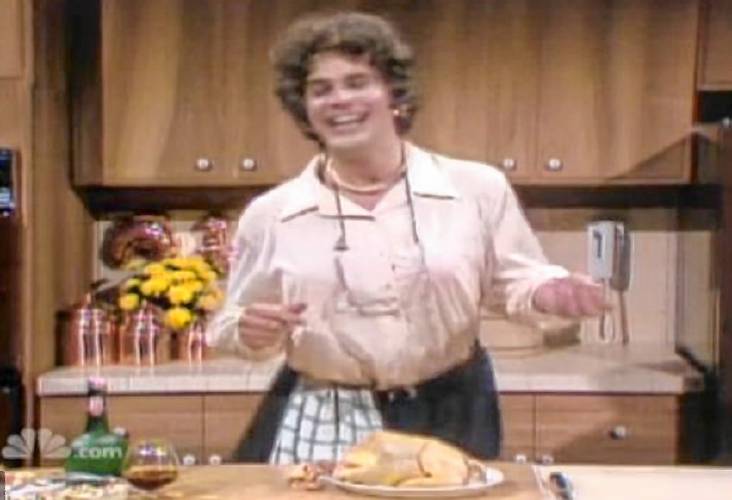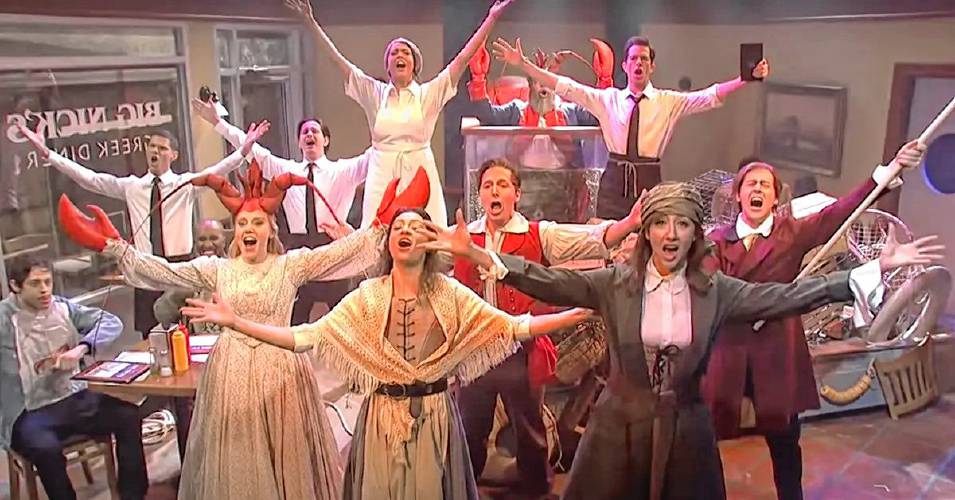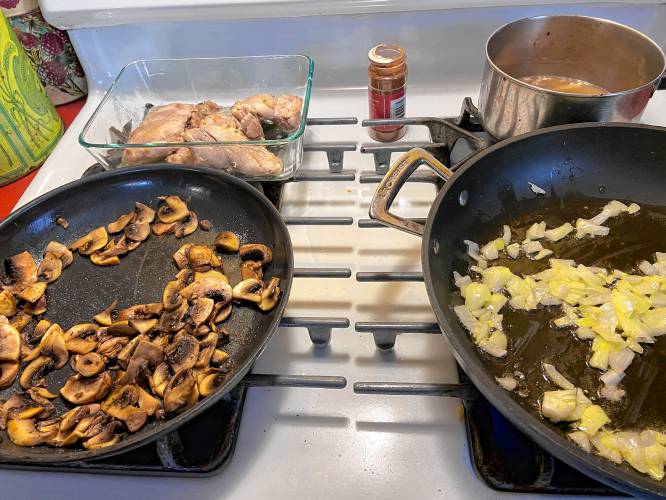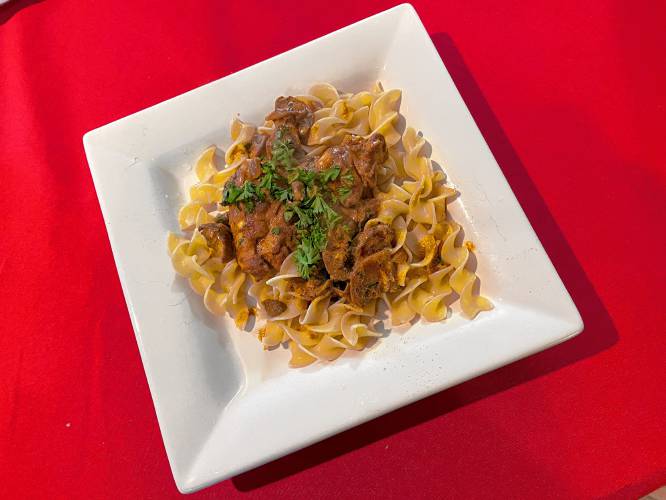Saturday Night Live, postmodernism and paprika: A recipe inspired by one of the 50-year-old show’s memorable sketches
| Published: 03-03-2025 1:44 PM |
We are awash in anniversaries this year. A century ago, in 1925, Mussolini rose to power in Italy. The Scopes Monkey Trial drew international attention to a modest courtroom in Dayton, Tennessee. Scotsman John Logie Baird aired the first public display of a television signal. And Irving Berlin published the eternal song “Always.”
In 1945, 80 years ago, World War II finally drew to a close. In January, those who were left in the Auschwitz concentration camp were liberated. In May, Germany surrendered. And in August the United States deployed atomic bombs in Hiroshima and Nagasaki, hastening the Japanese surrender.
In 1975, 50 years ago, Saigon fell to the North Vietnamese, marking the end of the Vietnam War. Francisco Franco, the longtime dictator of Spain, died. And “Saturday Night Live” debuted.
Those weren’t the only milestones that year, but they were the ones that stick in my head and, I would argue, in our collective memory.
Certainly, a lot has been written and broadcast lately about that last anniversary. As a regular “Saturday Night Live” viewer, I have consumed much of the coverage of the show’s birthday, including of course the 50th anniversary show a couple of weeks ago.
I am struck by the fact that the 1975 anniversaries seem disproportionately more current (perhaps with the exception of Franco’s death) than the ones from 1925 or 1945.
Humans in 1975 were as close to 1925 as we are to 1975, and they were only 30 years off from 1945. Nevertheless, the 1975 anniversaries seem almost contemporary, while the ones from the other decades appear far away.
This impression may well stem from the ways in which 1945 and its aftermath were a turning point for American and world civilization.
Article continues after...
Yesterday's Most Read Articles
The dropping of the atomic bomb in Hiroshima and Nagasaki in 1945 threw culture for a loop, although it took Americans a while to feel its effects. By the 1960s and 1970s, many of Americans’ certainties had been blown up. We recognized a new era, which philosophers dubbed postmodernism.
The characteristics of postmodernism pretty much sum up “Saturday Night Live.” Postmodern culture spends a lot of time reproducing, skewering, and mixing up previous cultural artefacts in what is known as pastiche. “Saturday Night Live” is pure pastiche.
In one of the myriad television specials celebrating the recent anniversary, ”SNL” founding (and current) producer Lorne Michaels reflected on the uncertainty of 1975.
“I remember, when we come on the air, we’re following Watergate, the last helicopter out of Vietnam. The city is broke. The church is being questioned. And so everything seemed to be, if not crumbling, at least open to question. That kind of moment in time,” he recalled.
To some extent, we still live in that kind of moment in time.
The format of “Saturday Night Live” has altered slightly over the decades. Nevertheless, the show’s basic structure of 90 minutes of live sketches and music at 11:30 on a Saturday night has endured over its 50 years.
What I think of as its reliable unreliability has also lasted. The show is never perfect. People are human, and sketches written in a single week are not meant to endure. As Michaels famously says, “The show doesn’t go on because it’s ready. It goes on because it’s 11:30.”
In almost every episode, however, there is a joke or a sketch that speaks to most audience members.
Not surprisingly, I have always been drawn to ”SNL” sketches that involve food. My all-time favorite food-related vignette also involves another passion of mine, musical theater.
In that 2018 segment “Diner Lobster,” cast member Pete Davidson has the gall to order lobster in a diner. (Apparently, this is a faux pas, at least in New York.)
The staff wheel out Kenan Thompson dressed as a combination of a lobster and Jean Valjean in “Les Misérables,” and the cast performs a parody of that musical, singing to save his life.
A barricade is erected, and the pro-lobster revolutionaries save the day. Davidson opts for another menu item.
I wasn’t the only person who loved that sketch. The lobster made a reappearance in the gala 50th anniversary show.
Much as I love “Diner Lobster,” I wasn’t shopping anywhere this week where lobster was available. In the end, my recipe was inspired by a 1978 segment in which original cast member Dan Aykroyd impersonates Julia Child as “The French Chef.”
While attempting to debone a chicken with the requisite very sharp knife, Aykroyd cuts his/her hand, and blood spurts everywhere. This description may not sound funny. Nevertheless, the audience ate up Aykroyd’s impersonation of Child’s unflappable manner. Child herself is said to have relished the sketch.
In tribute to “Saturday Night Live” I present a dish that turns chicken into a reddish but delicious mess.
You may of course use pieces of chicken that have skin and/or bones; I just used what I had in the house. If the chicken is thicker, cooking will take longer, and you may need more stock.
The only real trick with this recipe is to make sure that your paprika is relatively fresh. Jarred paprika can lose its flavor rather quickly.
Ingredients:
2 teaspoons butter plus more later
2 teaspoons olive oil plus more later
4 small pieces boneless, skinless chicken thigh
salt and pepper to taste
1/2 cup diced onion
4 tablespoons (1/4 cup) Hungarian paprika
2/3 cup chicken stock
1/2 pound mushrooms, sliced
sour cream to taste (start with 1/2 cup)
chopped fresh parsley to taste
Instructions:
Warm the butter and oil in a nonstick skillet. Add the chicken and cook over medium heat until it is lightly brown and cooked through, turning halfway through the process and sprinkling each side with salt and pepper. Remove the chicken from the pan and set it aside.
If the pan has a lot of fat in it, remove the fat. Add a little more butter and oil if needed and sauté the onions until they soften.
Add the paprika and stir. Stir in the chicken stock, and cook for 10 minutes more over medium-low heat.
While you are warming the stock and paprika, use a separate frying pan to sauté the mushroom pieces in a little more butter and oil.
Add the mushrooms and the chicken to the original pan. Add the sour cream, and stir until everything is warm but not boiling. At the last minute, stir in the chopped parsley.
Serve over noodles.
Serves 2 to 4, depending on appetite.
Tinky Weisblat is an award-winning cookbook author and singer known as the Diva of Deliciousness. Visit her website, TinkyCooks.com.










 Sounds Local: A legend pays tribute to an icon: Seven-time Grammy-nominated Joan Osborne brings Bob Dylan repertoire to Shea Theater
Sounds Local: A legend pays tribute to an icon: Seven-time Grammy-nominated Joan Osborne brings Bob Dylan repertoire to Shea Theater Speaking of Nature: Stinky signs of spring: Skunk cabbage is eye candy after months of winter landscape
Speaking of Nature: Stinky signs of spring: Skunk cabbage is eye candy after months of winter landscape For the love of peanut butter: April 2 is National Peanut Butter and Jelly Day
For the love of peanut butter: April 2 is National Peanut Butter and Jelly Day Women’s history told through clothing: Shelburne Falls Area Women’s Club to host ‘Real Clothes, Real Lives: 200 Years of What Women Wore’ author, April 9
Women’s history told through clothing: Shelburne Falls Area Women’s Club to host ‘Real Clothes, Real Lives: 200 Years of What Women Wore’ author, April 9
